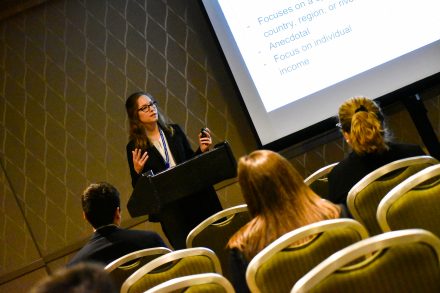Castillo's research examines if the overall economic health of an area improves or diminishes after a dam is constructed.
 Name: Bailee Castillo
Name: Bailee Castillo
Majors: Finance & Economics
Faculty mentor: Tonmoy Islam, assistant professor of economics
Title of research: A Dam Problem: Investigating the Influence of Dams on Economic Development
Abstract: Approximately 59,071 man-made dams have been constructed worldwide to control flooding, provide electricity, supply water, improve navigation routes, farm animals, etc.
There is an extensive list of dams that are planning on being built for rapid development. While the intention of these dams is positive, their installation has displaced between 40 and 80 million people worldwide.
The purpose of this study is to determine if the overall economic health of an area improves or diminishes after a dam is constructed. To address this question, a dataset from the Food and Agricultural Organization of the United Nations which contains characteristics of every man-made dam that has been constructed across all countries was combined with a dataset from NASA’s Socioeconomic Data and Application Centers which contains the GDP of every one degree of surface area of every continent.
Initial regression results show that in Africa and Asia, the presence of a dam has a nonlinear impact on the surrounding area’s GDP; areas close to the dam are negatively impacted, however, past a certain distance that is specific to each continent, the dam’s presence has a positive impact on the area’s GDP.
In other words: The main reasons why man-made dams are typically constructed are to control flooding, provide electricity, supply water, improve navigation routes, and farm animals. While these purposes may seem valuable, it is important to acknowledge that the construction of dams has displaced between 40 and 80 billion people worldwide. I decided to complete this study because I was curious to see if the economic benefit of dams is worth displacing millions of people.

Explanation of study/potential impact of findings: This study finds that dams play a significant role in economic development in Africa and Asia. The GDP of areas close to the dam are negatively affected by their construction; however, past a certain distance that is specific to each continent, the dam’s presence has a positive impact on the area’s GDP. This means that dams are not completely bad for the economy, but they do have direct negative implications on their surrounding area since they change the structure of the land.
Why did you pick this topic?
My study abroad program, Semester at Sea, led me to researching dams for my thesis. In my Economic Development class, I learned about how dams influenced development in China. In my Geology class, I learned about how dams change the structure of rivers. In Ghana, I did a homestay and one of the members of my host family was the manager of the dam on Lake Volta. Since dams seemed to be a common theme during my time abroad, I took this as a sign that I should use it as my Honors thesis research topic.
How has your mentor impacted you/your research process?
Dr. Tonmoy Islam has been my mentor for the past two years. As an Honors fellow, I was required to get a mentor by my junior year in order to complete my two-year thesis project. Dr. Islam was my Econometrics professor my sophomore year, and thankfully he agreed to mentor me during my research process. He is available anytime I need him, and he has aided me in my coding skills tremendously. We are constantly bouncing ideas off each other whenever we hit a bump in the road with coding or need to figure out which direction to take the research. My thesis would not be where it is today without him, and I am incredibly grateful for all of his support and guidance.


